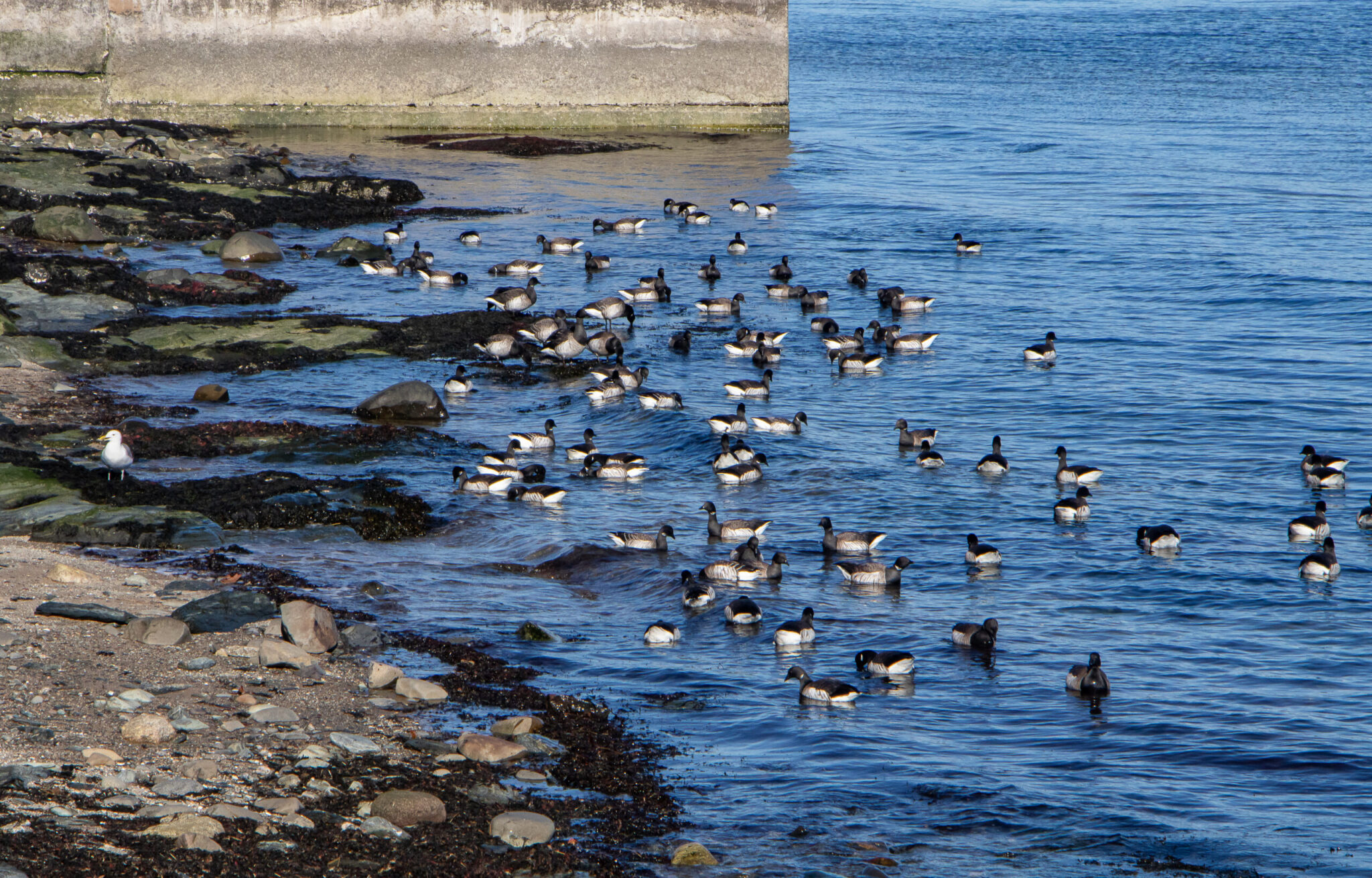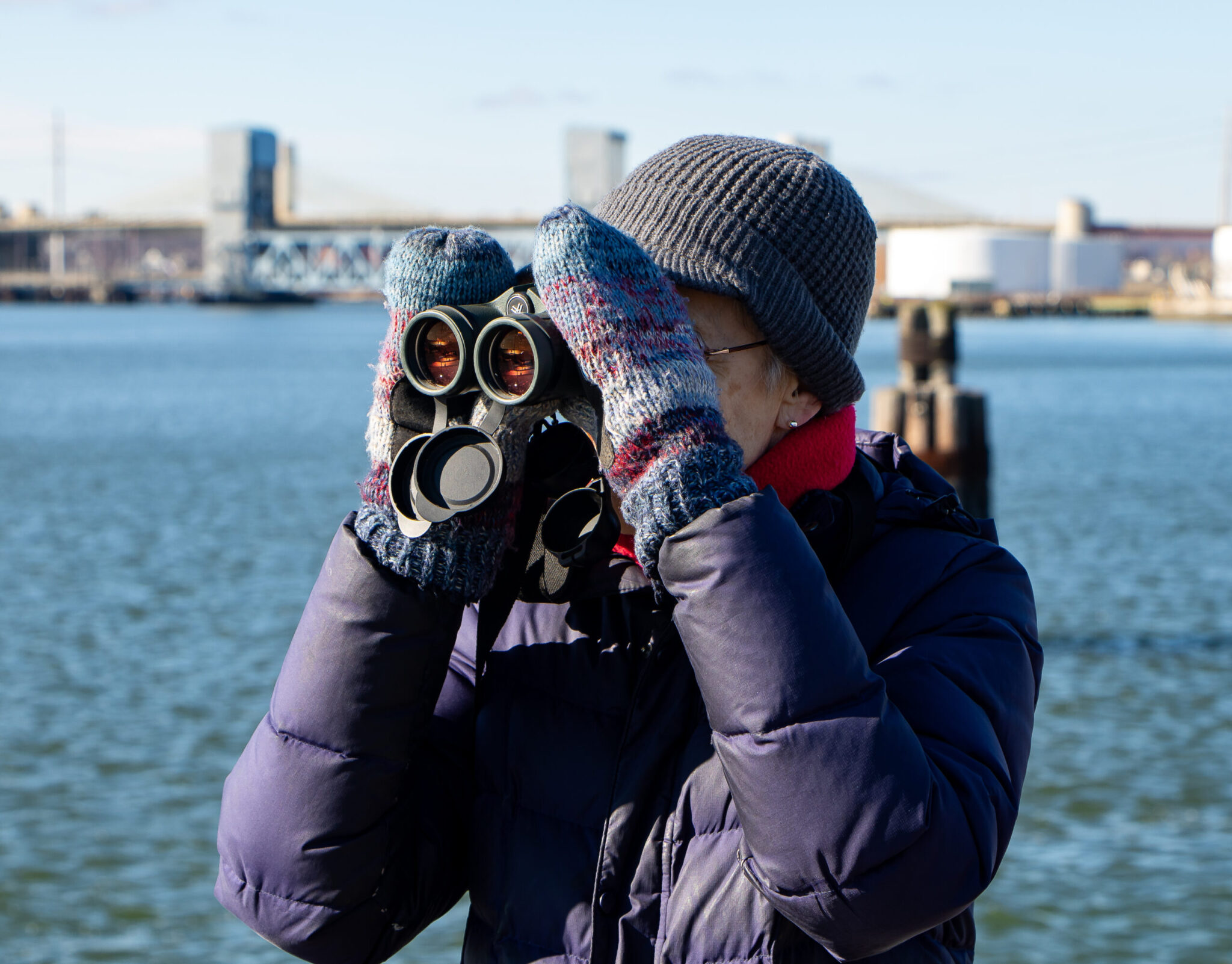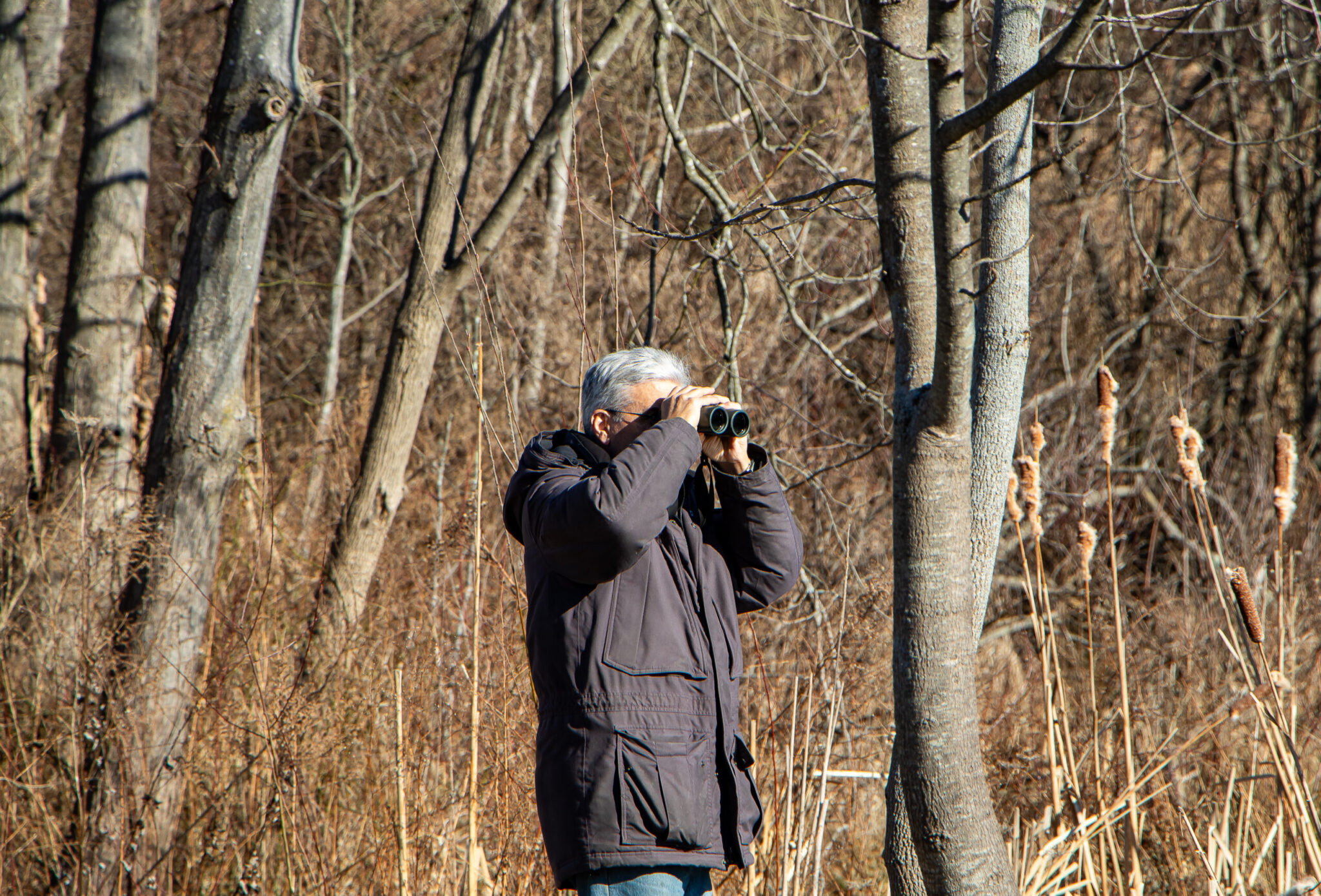
Photos by Gavin Guerrette
There are certain expectations that come along with turning 21. You’re expected to become more mature and to know what you want in life. Really, though, those are distant expectations. The most immediate expectation of turning 21 is, of course, that you will get absolutely, completely wasted. This was my friends’ demand for me on the night of my 21st birthday party. Over and over, they approached me and asked “How drunk are you getting tonight?” To their confusion, and to my mild amusement, I answered, “Well…only drunk enough that I can get up at eight A.M. to go birdwatching tomorrow.” Maybe I was maturing.

The birdwatching trip I had planned was not your average, walk-through-East-Rock, see-one-or-two-birds-affair. No, I was tagging along with a team of skilled birdwatchers as they took part in the Mega-Bowl, an 11-hour bird-watching competition that takes place throughout Connecticut each February. The competition is held by the New Haven Bird Club, one of the nation’s oldest birding organizations.
Chris Loscalzo, a Professor at the Yale School of Medicine and an NHBC member since 1990, would be my guide. He was also the competition’s organizer and the one who founded it eight years ago. He’s ranked 60th in the state on E-Bird — an app where birders track the number of species they’ve seen.
So, armed with less than 6 hours of sleep and the tenacity of a (newly turned) 21-year-old, I woke up at 8:30 AM and got ready to find some fowls. Joining me on the trip were my friends (and Mag editors) Audrey and Gavin. Chris had texted me to meet him and his birding team — the “Winter Wrenegades” (badum-tss) — by the Amistad Schooner Replica’s home pier at Long Wharf. One quick breakfast stop later, we arrived. We get out of the van and look out at the rocky coastline and the Herring Gulls (yellow-beaked and gray-winged birds) swooping overhead. Audrey wonders out loud which of us will be the first to get pooped on. We make our way towards the pier, walking past a man surrounded by a flock of about thirty or so gulls. He tears off palm-sized chunks of a baguette and lobs them into the waiting crowd.
Chris and his three teammates — Marianne Vahey (his wife, 76th on E-Bird), Judy Moore (71st on E-Bird), and Jack Swatt (58th on E-Bird) — have already set up at the pier’s end, where the narrow path broadens into an outlook. With them, they have two spotting scopes, low-powered tripod-mounted telescopes that birders use for spotting otherwise indistinguishable birds. One is pointed out towards the horizon, and the other is pointed towards three birds rocking on the waves, about 50 feet away.
As Audrey, Gavin and I approach, Chris introduces us to the team and launches into an explanation of the competition’s rules; Mega Bowl competitors are tasked with finding as many species of birds as possible within the hours of 6:00 AM and 5:00 PM on a designated day. The birds range in point value, with the most common valued at only one point and the least common valued at seven. “And then seven — touchdown! Seven points is if you find a bird that’s, like, never been seen in Connecticut, in February, before,” Chris tells us. On the scorecard, the 7 point slots don’t even have birds listed next to them. They all read “7 ______________.”
Chris gestures towards the scopes. He takes a look in to adjust the lens for us. “Might be able to see — oh, wow — there’s a whole flock of birds that are called lesser scaups.” They are black-headed ducks with wings striated in black and white. “That’s a three point bird,” he adds.
For each point that a team earns, Chris and Marianne donate 50 cents to an organization of the team’s choice. By the end of this year’s competition, they’ll have donated 1,050 dollars to various organizations including the Connecticut Audubon Society, A Place Called Hope (a bird rehabilitation center in Killingworth), and the New Haven Bird Club itself.
Having logged all the birds at this location, the Wrenegades pack up their scopes and begin walking back to their car. Along the way, I ask Chris how long he’s been birding. “I started 50 years ago, I’m 64 years old.”
“I was about 12 or 13 years old, and I lived near a horse farm,” he says. “Anyways, there’s this little old lady who owned a horse, and she couldn’t take care of it. So she asked me and a friend ‘Hey, can you take care of our horse for us?’ We said ‘Sure, of course.’ Anyway, as a way of thanking us, she invited us to her house […] and she had bird feeders. She was putting birdseed in, and I was amazed at all the different birds right there. I’d never seen so many birds.”

He goes on to tell me about his spark bird — the species which got him invested in the activity. “It was probably the Red-bellied Woodpecker, and after that it was Evening Grosbeak. That was the one that really got me going. A really spectacular looking bird.” Later, after getting home, I google the Grosbeak. It is a small, terrestrial bird of gold and black. A yellow line traces across its forehead, and its mustard underbelly comes up into sharp, black wings. I forget, sometimes, that there are things more vibrant than paint.
We head next to the Sound School — a self-described “regional, vocational aquaculture center” located 1.5 miles away — and see a few Red-breasted Mergansers, black ducks with long, red beaks and mussed feathers along their heads. “Doesn’t it look like they’re having a bad hair day?” Chris says.
We stay for a few more moments, and then we pack up and head to Oyster River Point, a suburban street that comes up right against the ocean. A woman living in the neighboring house comes out to ask what birds we’re seeing.
“I only see the ones closer because I have regular binoculars,” she says.
“You can come and see him in my scope right now,” Chris replies. He waves her over, and she begins to look at a few Wigeons — brown ducks with black-tipped wings and brilliant green streaks across their heads. They bob on the waves, occasionally tipping their body over to search for food underwater.
While Chris points out more features, Marianne waves me to the other scope so I can get a look. I ask her about how she and Chris met, and she tells me they met in medical residency. At the time that they met, Marianne was not a birder. However, a few months into dating, Chris began to pish — a bird call used to bring out hiding birds — while on a walk. An Eastern Towhee jumped right out. It was (birding) love at first sight.

Our penultimate stop is Merwin Point in Milford. We get out of the car to find ourselves in yet another suburban neighborhood on the coastline. Black rock juts out along the shore like it was made of liquid and frozen midair.
I walk with Judy along the shoreline as the others go ahead. She began birding later than Chris and Marianne. “One day I left my son at nursery school, which was right next to the woods and a park,” she tells me. “It was early and I just sort of stepped inside the woods, and all of a sudden all these birds surrounded me and we had what we call a fallout of spring warblers.” A fallout is when many birds descend from the sky and onto land, usually caused by rain. “There must have been species of these…and I was just smitten,” she says.
Suddenly, Judy points in front of us. “Sandpiper at the very tip of that rock.” 3 points.
Chris and Jack dash to set up the scopes to see if they can spot it, and Jack realizes that there’s actually a whole flock of them lurking on the rock’s other side, only visible from further back.
We wait for a few more seconds to see if they’ll walk out to the front, but they refuse. So the scopes are packed and we begin to walk back to the cars.
About a street away, a brown streak shoots overhead. “Cooper’s Hawk!” Chris shouts.
We rush around the corner, hoping that the whole team will be able to see it, but it isn’t there.
*****
The next day, I walk out of LC to find Cody Limber, my ride to the celebratory dinner who’s ranked 55th on E-Bird. On the 27-minute drive to the dinner held in Derby, he told me about his research as a PhD candidate in Richard Prum’s Ornithology lab. Cody had taken his love of birds full time.
By day, he researches the categorization and development of feather cells in chickens, and by night and by weekend (and sometimes by day, instead of work), he chases birds. “Birders do very silly things, and sometimes that means driving like an hour each way to see one individual bird,” he said. In fact, that’s what he’d been doing before he picked me up. He had driven an hour north in search of a Hermit Warbler which another birder had spotted and was returning victorious.
As we drove, Cody craned his head close to the dashboard each time a bird passed overhead, pointing out each one. I asked Cody how far away he could identify a bird from. “Depends on the birds,” he answered, before admitting, “Yeah, pretty far.”
We arrived at the dinner’s venue, the Kellogg Environmental Center. Inside, past a small, wood-paneled lobby, laid a large room filled with taxidermied birds, wooden, whale models and, curiously, a small pond. In it, two turtles — one the size of my palm and the other the size of my head — bobbed around.
We walked past the turtle pond and into the center’s banquet hall, just as Chris was telling everyone about the food. Marianne had made it all: rice, meat and vegan chili, vegetable stir fry, pumpkin soup and chicken noodle soup for about thirty people. Flannel, as well as patterned shirts and puffer jackets, was popular among the gathered birders. I was one of the only people of color. Later, Chris attempted to find out who the oldest and youngest birders in the crowd were. When he said “keep your hand up if you’re over 60,” half of the crowd’s hands were still up.
These demographics aren’t news to Chris. The day before, as we walked along Merwin Point, he’d told me “It tends to be somewhat affluent, Caucasian people that tend to be birdwatchers. You know, it’s hard to be a birdwatcher if you’re just working every minute just to make a living and put food on your table. Yeah, it’s a privilege to be able to do this on a day off and have fun.”
In addition to a difference in free time, birding’s lack of diversity also seems to stem from the racism of its pioneers. John James Audubon, a pioneering naturalist and the Audubon Society’s namesake, was a slave owner. William Cooper, the namesake of the Cooper’s Hawk, was also a slave owner. That’s why, last November, the American Ornithological Society announced that it was taking Cooper out of the hawk, along with changing the name of every bird named after a human. They hoped this change would “engage far more people in the enjoyment, protection, and study of birds.”
Although the change isn’t without its detractors, Chris instead sees it as an opportunity to give birds more appropriate noms de plume. “Some of the best bird names give you a clue as to either what habitat they like, color, or, you know, plumage feature. They have a purple head, you can call it a Purple-Headed Warbler.”
Cody and I sit down at a table near the front of the banquet hall, next to other birdwatchers who were friends of Cody’s. There’s a bowl of m&ms in front of us, and I feel a bit like I’m eating birdseed as I pick up a few in my fingers. The three birders begin to chat about owl feather evolution, before switching topics to chicken plumage and then to bird banding.
Soon, Chris comes to the front of the room and begins a small speech about the competition’s history and where this year’s donations were headed. Then, he moves on to the competition’s results. Cody’s team — “Egrets, I have a few…” — had won one of the top prizes. The rest of the room groaned in response to the announcement. This was a yearly occurrence, I guessed.
After Chris hands out the prizes — bird paintings and suet feeders — for the top teams, he thanks everyone for coming, and people begin to pack up. At Chris and Marianne’s insistence, I pack some food to go while Cody talks about his Costa Rican birding experience with Chris.
*****
Campus is cold compared to the warmth of the birding dinner — indoor heating and people who know each other. The generosity of the birders is not lost on me. Allowing three college students to tag along on their birding expedition and pelt them with endless questions is a kind act. These birders, like anyone else, want more people to love what they love. Despite this kindness, though, I don’t know how long it might take to feel part of this community. There are the facts of representation, racial or otherwise; and there are the facts of dedication. If I started now, I would be 71 by the time I had as much birding experience as Chris. Maybe this will just be the story I tell myself in 20 years when I try to remember how I spent my 21st birthday — I saw some birds, I met some people, and I tried something new.
A few days later, the weather is nice enough for running, so I slip on my sneakers and jump outside. The birds — tucked, out of sight, on some tree branch — are especially loud today. I pull out my phone and open MerlinID, a bird call identification app. I press record. American Bluejay. I try looking for their blue feathers again, but I can only hear their caw.








